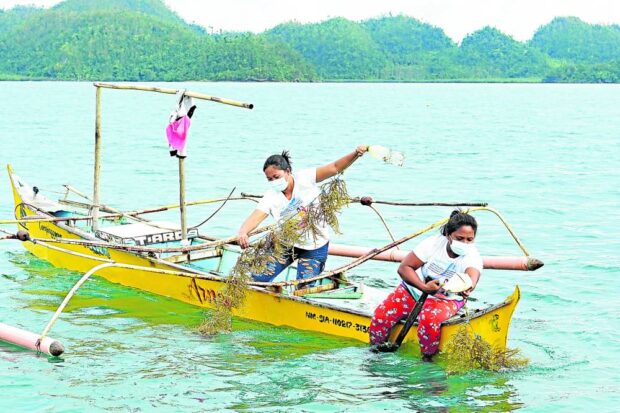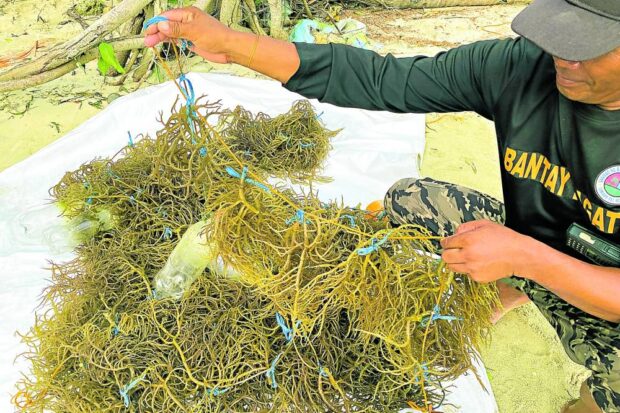Siargao fishers rediscover economic boon in seaweeds

LIFELINE Women growers check a seaweed line in the waters off San Benito town in Surigao del Norte province. —PHOTO BY ERWIN M. MASCARIÑAS
SAN BENITO, Surigao del Norte, Philippines — Holding a bunch of brown seaweeds, Coreta Espanso proudly relates that her cultivation of the marine algae helped fund her second child’s completion of a college degree last year.
Like Espanso, most women of Sitio Campinganon, an islet in Barangay Maribojoc on Siargao Island, tend seaweed farms to help augment their husbands’ income from fishing hence, it was more of a secondary livelihood activity.
The situation changed after Supertyphoon Odette (international name: Rai) struck Siargao in December 2021 when their husbands’ fishing gear was destroyed, and there were no off-fishing jobs available in the local tourism circuit.
Odette’s lashing winds wiped out the flourishing seaweed farms in Campinganon, dealing them a double whammy after the devastating impact of the COVID-19 pandemic.
Just when the villagers were about to give up hope, they saw some stroke of luck.
Article continues after this advertisement“In what most of us considered as a miracle of sorts, my family was able to keep some of the seedlings safely and it was these that we distributed to the community for everyone to slowly start planting,” recalled Espanso, a member of the Campinganon Women’s Association.
Article continues after this advertisementThriving through sharing
Lo and behold, it kept the islet residents economically afloat during the crucial months after emergency food support from the government had already stopped.
“It was hard to imagine how we could have survived and gotten back on our feet after Odette destroyed everything. It was through our cultivation of seaweeds that we were able to rise and now thrive,” said Espanso.
While waiting for financial aid to rebuild damaged and lost fishing gear, the women’s husbands devoted their time to tending to the seaweeds, doubling the cultivation effort.
Each seaweed grower of Campinganon harvests around 50 kilos a month, which sells from P2,000 to P3,000 in the local market. It is a main offering in restaurants catering to tourists in Siargao.
Demand has increased with the steady influx of leisure travelers into the island famed for its waves perfect for surfing and other pristine natural attractions.
Seaweed cultivation in San Benito, which faces the Pacific Ocean, started in 2007, with only a handful of households devoting their time to it due to low prices offered by traders, noted municipal agriculturist Gina Mendavia.

Fresh seaweeds are prepared for delivery to restaurants on Siargao Island where these are in high
demand, in turn providing families growing these a steady economic lifeline. —PHOTO BY ERWIN M. MASCARIÑAS
Empowering women
In 2015, nongovernment group Sentro para sa Ikauunlad ng Katutubong Agham at Teknolohiya Inc. (Sikat) helped organize the Hugpong nan Mananagat sa Sitio Campinganon for the enforcement of fishery laws so that the marine environment would be protected and preserved.
It included supporting women in having a livelihood of their own, through seaweed farming.
“By providing support for women, we empower them to be able to help their families. As their husbands are out fishing, these women are tending to their seaweeds, giving them an opportunity to be more productive,” Sikat said in a statement.
Espanso said she considered seaweed farming as a form of “women empowerment” as it allows them to earn money and contribute to the family’s income, even if their husbands were on fishing trips.
“Our husbands go out to sea to fish while us, women, stay at home to take care of the household and children. However, with the introduction of seaweed farming, we now have the opportunity to generate income and take on a more active role in our community’s economy,” she said.
New market
The growth of tourism in Siargao provided a new market landscape for seaweeds, driving an increase in the number of cultivators, according to Mendavia.
The success story of Campinganon women seaweed growers had also encouraged others to follow in their footsteps.
The municipal agriculture office noted that from only 3 hectares operated by a few households, seaweed farms now expand to some 8 ha with 34 households overseeing these.
In Dapa town, at the other side of Siargao Island, some 10 households began their cultivation ventures.
But Mendavia admitted that these ventures faced a number of challenges. For one, Espanso said that severe weather conditions cause significant damage to seaweed farms, resulting in a decrease in productivity and profits for the planters.
“Even when there is no typhoon, excessive rainfall can also damage the seaweed farms. Too much rainfall can cause the water to become murky, making it difficult for sunlight to penetrate the water and reach the seaweed. This can stunt the growth of the seaweed and reduce yield,” she added.
To hedge against these, the Bureau of Fisheries and Aquatic Resources and the Department of Trade and Industry, along with several nongovernment organizations, stepped in to provide training on value-adding for the seaweed products.
“When fresh seaweeds are not sold, they are at risk of spoiling, resulting in lost income for the farmers. By processing the seaweeds into value-added products such as pickles and crackers, the farmers can extend the shelf life of their products and increase their profitability,” said Mendavia.
Farmers, she pointed out, also sell their freshly harvested seaweeds to hotel owners and restaurants in nearby towns in Siargao like General Luna.
“Although hotels and restaurants in Siargao make up only a small percentage of the total buyers of seaweed, their support for the local seaweed industry is still significant. By buying fresh seaweed from local suppliers and using it in their dishes, they are helping create a stable market for seaweed planters, promoting sustainable farming practices, and supporting the livelihoods of local farmers,” Mendavia added.
This augurs well for the sustainability of financial returns for growers as well as of the environment in Siargao if seaweed cultivation further expands.
Seaweed has been shown to be a highly effective carbon sink, absorbing large amounts of carbon dioxide from the atmosphere, according to the study, “Blue Growth Potential to Mitigate Climate Change through Seaweed Offsetting,” published in the journal Current Biology in August 2019.
(Editor’s Note: This story was produced through a grant from Oxfam Pilipinas.)
RELATED STORIES
Marine scientist pursues 47-yr study, uses of seaweeds
Fishers’ wives earn at seaweed farms